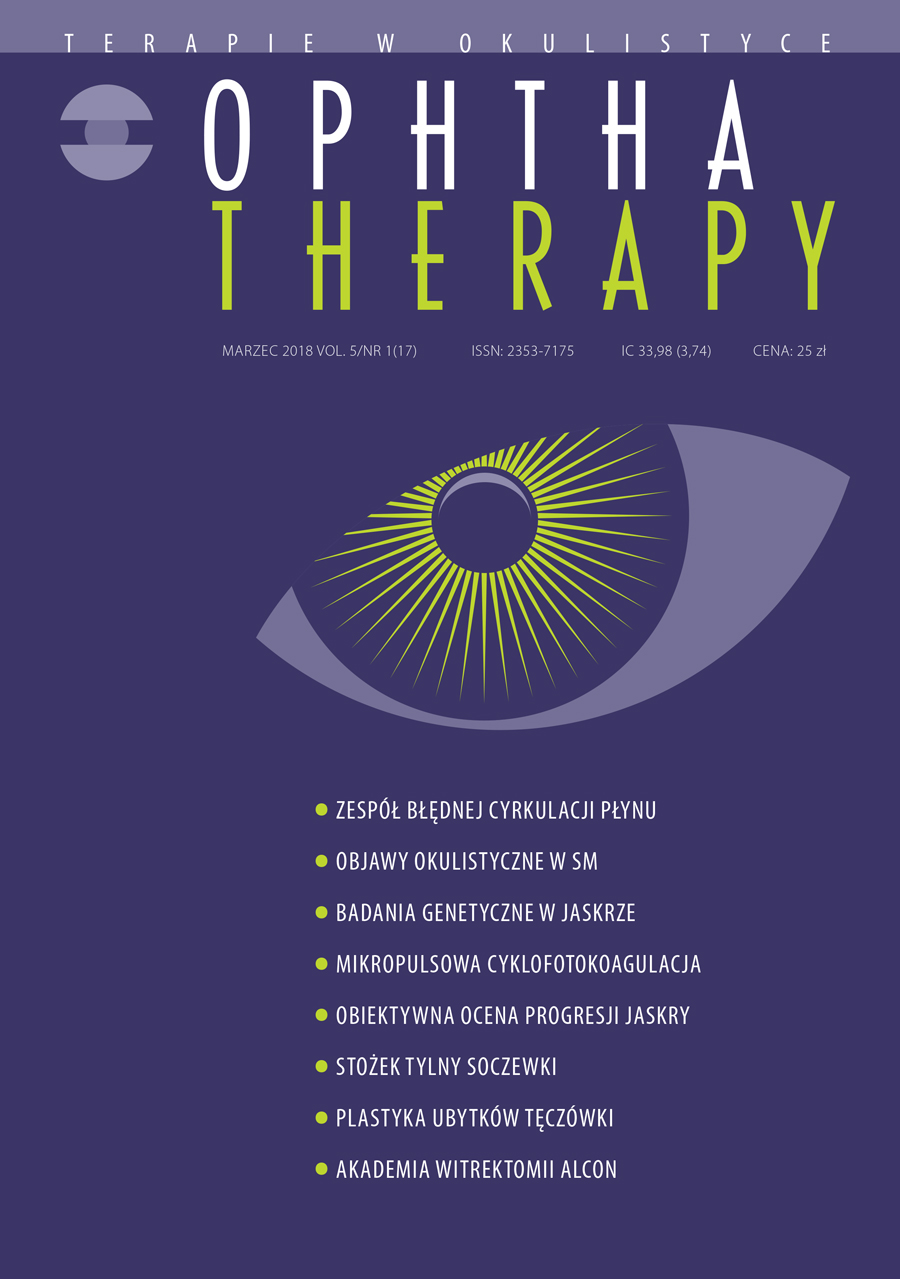Badania genetyczne w jaskrze – aktualne możliwości
##plugins.themes.bootstrap3.article.main##
Abstrakt
Czynniki genetyczne odgrywają istotną rolę w etiopatogenezie jaskry. Gwałtowny postęp genetyki pozwolił na poznanie genów przyczynowych jednogenowych postaci jaskry (zwłaszcza jaskry wrodzonej) oraz genów predysponujących do wieloczynnikowych postaci jaskry (zwłaszcza jaskry pierwotnej otwartego kąta). Wykonywane obecnie u pacjentów z jaskrą badania molekularne obejmują geny CYP1B1, LTBP2 i TEK w pierwotnej jaskrze wrodzonej, geny PITX2 i FOXC1 w zespołach dysgenezji odcinka przedniego oraz geny MYOC i OPTN w jaskrze pierwotnej otwartego kąta. Badania te mają znaczenie nie tylko diagnostyczne, lecz także często rokownicze i terapeutyczne.
Pobrania
##plugins.themes.bootstrap3.article.details##

Utwór dostępny jest na licencji Creative Commons Uznanie autorstwa – Użycie niekomercyjne – Bez utworów zależnych 4.0 Międzynarodowe.
Copyright: © Medical Education sp. z o.o. License allowing third parties to copy and redistribute the material in any medium or format and to remix, transform, and build upon the material, provided the original work is properly cited and states its license.
Address reprint requests to: Medical Education, Marcin Kuźma (marcin.kuzma@mededu.pl)
Bibliografia
2. Akarsu AN, Turacli ME, Aktan S et al. A second locus (GLC3B) for primary congenital glaucoma (buphthalmos) maps to the 1p36 region. Hum Mol Genet. 1996; 5: 1199-203.
3. Stoilov IR, Sarfarazi M. The third genetic locus (GLC3C) for primary congenital glaucoma (PCG) maps to chromosome 14q24.3 (Abstract). Invest Ophthal Vis Sci. 2002; 43: e3015.
4. Firasat S, Riazuddin SA, Hejtmancik J, Riazuddin S. Primary congenital glaucoma localizes to chromosome 14q24.2-24.3 in two consanguineous Pakistani families. Mol Vis. 2008; 14: 1659-65.
5. Souma T, Tompson SW, Thomson BR et al. Angiopoietin receptor TEK mutations underlie primary congenital glaucoma with variable expressivity. J Clin Invest. 2016; 126: 2575-87.
6. Ali M, McKibbin M, Booth A et al. Null mutations in LTBP2 cause primary congenital glaucoma. Am J Hum Genet. 2009; 84: 664-71.
7. Semina EV, Reiter R, Leysens NJ et al. Cloning and characterization of a novel bicoid-related homeobox transcription factor gene, RIEG, involved in Rieger syndrome. Nat Genet. 1996; 14: 392-9.
8. Nishimura DY, Swiderski RE, Alward WL et al. The forkhead transcription factor gene FKHL7 is responsible for glaucoma phenotypes which map to 6p25. Nat Genet. 1998; 19: 140-7.
9. Fischbach BV, Trout KL, Lewis J et al. WAGR syndrome: A clinical review of 54 cases. Pediatrics. 2005; 116: 984-8.
10. On-line Mendelian Inheritance in Man. Online: http://omim.org/entry/137760.
11. Stone EM, Fingert JH, Alward WL et al. Identification of a gene that causes primary open angle glaucoma. Science. 1997; 275: 668-70.
12. Rezaie T, Child A, Hitchings R et al. Adult-onset primary open-angle glaucoma caused by mutations in optineurin. Science. 2002; 295: 1077-9.
13. Pasutto F, Keller KE, Weisschuh N et al. Variants in ASB10 are associated with open-angle glaucoma. Hum Mol Genet. 2012; 21: 1336-49.
14. Monemi S, Spaeth G, DaSilva A et al. Identification of a novel adult-onset primary open-angle glaucoma (POAG) gene on 5q22.1. Hum Mol Genet. 2005; 14: 725-33.
15. Pasutto F, Matsumoto T, Mardin CY et al. Heterozygous NTF4 mutations impairing neurotrophin-4 signaling in patients with primary open-angle glaucoma. Am J Hum Genet. 2009; 85: 447-56.
16. Fingert JH, Robin AL, Stone JL et al. Copy number variations on chromosome 12q14 in patients with normal tension glaucoma. Hum Mol Genet. 2011; 20: 2482-94.
17. Aung T, Ocaka L, Ebenezer ND et al. A major marker for normal tension glaucoma: association with polymorphisms in the OPA1 gene. Hum Genet. 2002; 110: 52-6.
18. Thorleifsson G, Magnusson KP, Sulem P et al. Common sequence variants in the LOXL1 gene confer susceptibility to exfoliation glaucoma. Science. 2007; 317: 1397-400.
19. Andersen JS, Pralea AM, DelBono EA et al. A gene responsible for the pigment dispersion syndrome maps to chromosome 7q35-q36. Arch Ophthalmol. 1997; 115: 384-8.

